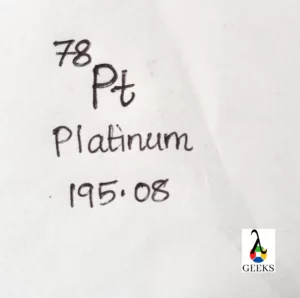Platinum is one of the least reactive rare or element in the earth crust let us discuss about various facts related with platinum.
Platinum is a least reactive silver white metal found in the periodic table. It is a lustrous,ductile and malleable substance. It is mostly found in the alluvial soil of various rivers with concentration 0.005 ppm in the earth crust. It’s crystal structure is fcc and it forms various halides,oxides and acetate.
Ziese’s salt is a platinum containing organo metallic compound. Let us discuss about various facts of platinum like its Ionic radius, isotope, allotropes in the following sections.
Platinum Symbol
An element in the periodic table can be easily represented by assigning a symbol. Let us look into the symbol of platinum.
The chemical symbol of the platinum is Pt. This symbol is derived from A Spanish letter platinum that means a diminutive of plata “silver”.

Platinum Group in Periodic Table
A group is a column in the periodic table with elements having same outer electronic configuration.Let us see in which group platinum belongs.
Platinum belongs to group 10 in the periodic table. It’s is present after nickel(Ni), palladium (Pd) and before darmstadtium(Ds).
Platinum Period in Periodic Table
The horizontal rows found in the periodic table is known as the periods. Let us look into the period of platinum.
Platinum belongs to period 6 of the periodic table. It is present in between iridium(Ir) and gold(Au)
Platinum Block in Periodic Table
A periodic table is the arrangement of elements in Earth crust in accordance with their chemical and physical properties. Let us discuss about block of platinum in periodic table
The periodic table’s d block is where platinum is located. It is as a result of the final electron entering into atom’s d orbital. It can be also called as a transition metal.
Platinum Atomic Number
The atomic number defines the number of protons or electrons present in an atom. Let us discuss about the atomic number of platinum.
The atomic number of platinum is found to be 78. This means it has 78 protons or electrons.
Platinum Atomic Weight
Atomic weight is simply the mass of an atom. Let us look into the atomic weight of platinum.
The atomic weight of platinum is 195.084. this atomic weight can be increased or decreased up to 0.009.
Platinum Electronegativity according to Pauling
The capacity of an atom to draw electrons into itself is known as electronegativity. Let us discuss about the electronegativity of platinum in accordance with pauling scale.
The electronegativity of platinum according to pauling scale is 2.28.
Platinum Atomic Density
Atomic density of an atom is defined as the number of atoms present per unit centimetre cube or volume. Let us look into the density of platinum.
The atomic density of platinum is 21.45 g/cm3 when it is it solid state. When it is converted to a liquid then its atomic density is found to be 19.77 g/cm3 .
Platinum Melting Point
The melting point of an element is the temperature at which it is converted from solid to liquid. Let us look into the melting point of platinum.
Platinum has a melting point of 2041.4 K, or 1768.30 C.
Platinum Boiling Point
The temperature at which an element’s vapour pressure equals that of the atmospheric pressure is its boiling point. Let’s talk about platinum’s boiling point.
The boiling point of platinum is 4098 K or 38250 C.
Platinum Vanderwaals Radius
Vanderwaals Radius is the half the distance between the centre of nuclei of two atoms held together by vanderwaal force. Let us study about the vanderwaals radius of platinum.
The vanderwaals radius of platinum is 175 pm. It is greater than its covalent radius.
Platinum Ionic or Covalent Radius
The covalent radius is half the distance between the centres of two covalently bound nuclei. Let us look into the ionic radius of platinum.
The Ionic or covalent radius of platinum is 136pm.
Platinum Isotopes
A member of an element’s family with the same number of protons but a different number of neutrons is said to be an isotope. Let’s research the platinum isotopes.
Platinum has 6 natural isotopes. Except two all the other isotopes are found to be very stable. The following are the isotopes of platinum.
| Isotopes | Abundance |
|---|---|
| 198Pt | 7.356% |
| 190 Pt | 0.012% |
| 192 Pt | 0.782% |
| 193 Pt | syn |
| 194 Pt | 32.864% |
| 195 Pt | 33.775% |
| 196 Pt | 25.211% |
Platinum Electronic Shell
The electrons present in an atom is filled in various electronic shells. Let us discuss about the electronic shell of platinum.
Platinum has six electronic shells. They are 2,8,18,32,17,1.
Platinum Energy for First Ionization
The amount of energy required to eject the most slackly held electron from an atom’s outermost shell is known as the ionisation energy.. Let us discuss about the first ionization energy of platinum.
Platinum has a first ionization energy value of about 870 KJ/mol. Since the most loosely held electron is far away from the nucleus it can be easily removed. So platinum has low first ionization energy.
Platinum Energy for Second Ionization
The energy needed to expel the electron from a monopositive ion is known as an element’s second ionisation energy.
The second ionization energy of platinum is found to be 1791 KJ/mol. Here the second electron is needed to be removed from the d orbital and it requires more amount of energy so that’s the reason for high second ionization energy for platinum.
Platinum Energy for third Ionization
The energy needed to expel an electron from a dipositive ion is an element’s third energy. Let us look into the third ionization energy of platinum.
There is no third ionization energy is found for platinum.
Platinum Oxidation States
The total number of electrons that the atom has gained or lost can be used to characterise its oxidation state. Let us discuss about the oxidation states of platinum.
Platinum has 10 oxidation States. They are -3, – 2 ,- 1, 0,+ 1,+ 2, + 3, + 4, + 5,+ 6.
Platinum Electronic Configuration
Electronic configuration is the arrangement of electrons of an atom in the various shells. Let us deal with the electronic configuration of platinum.
The electronic configuration of platinum is 4f14 5d9 6s1.
Platinum CAS Number
Every chemical substance is given a CAS number, a special identifying number, by the chemical abstracts service.Let us know about the cas number of platinum.
The cas number of platinum 7440-06-4.
Platinum ChemSpider ID
ChemSpider is a free chemical structure database providing fast text and structure to chemical substance. Let us discuss about the chemspider ID of platinum.
The chemspider ID of platinum is 22381.
Platinum Allotropic Forms
Allotropes is the existence of more than one chemical form of an element. Let us look into the allotrope of platinum.
There is no allotrope is found for platinum. It has only one solid form.
Platinum Chemical Classification
Chemical classification is the classification of an element dependent on the properties and electronic configuration. Let us look into chemical classification of platinum.
Platinum is a group d element or a transition metal where the last electron enters into the d orbital. Platinum belongs to group ten and period six of periodic table.
Platinum State at Room Temperature
The chemical state of an element is due to its electronic, physical and chemical properties. Let us look into the state of platinum at room temperature.
Platinum is a solid at room temperature.
Is Platinum Paramagnetic?
When an object has unpaired electrons, it is clearly a paramagnetic substance. Let us check whether platinum is paramagnetic or not.
Platinum is paramagnetic in nature. It is as a result of the unpaired electrons that are present there. 4f14 5d9 6s1 is the electrical configuration. Here there is a presence of unpaired electrons in both s and d orbital that indicate that it is paramagnetic in nature.
Conclusion
Platinum is a transition metal which is resistant to corrosion at even high temperature. It can cause numerous health issues when exposed to its salt. It is utilised in electrical contacts, electrodes, jewellery, and catalytic converters, among other things.

Hi… I am Aparna Dev, a chemistry Postgraduate with a good understanding of chemistry concepts. I am working in Kerala Minerals and Metals Limited Kollam with experience in the development of electrocatalysts as a part of post graduate thesis.
Let’s connect through LinkedIn-https://www.linkedin.com/in/aparna-dev-76a8751b9